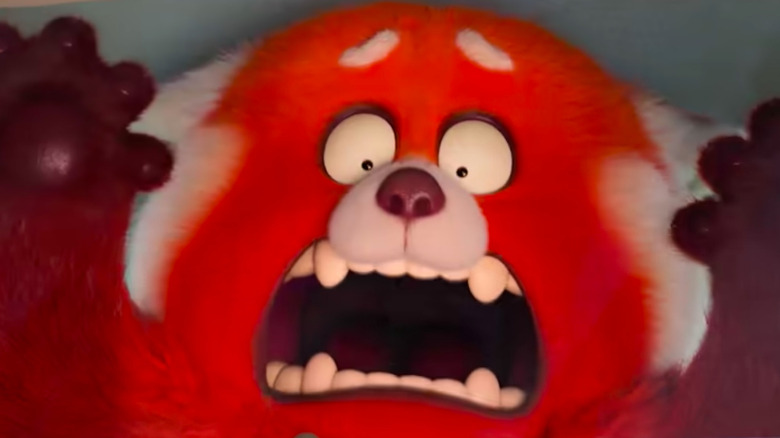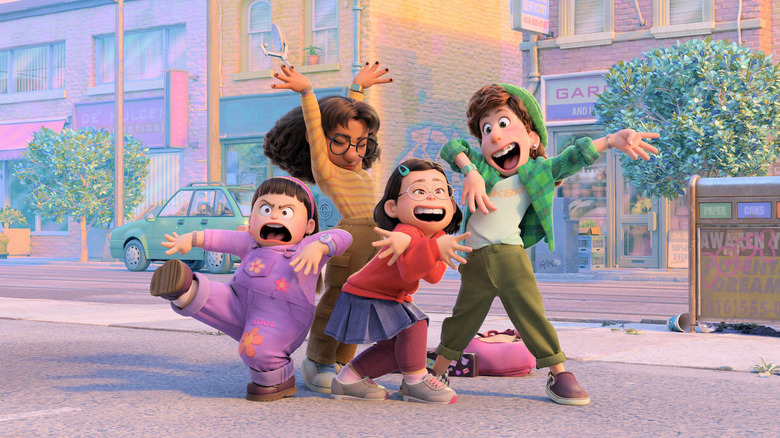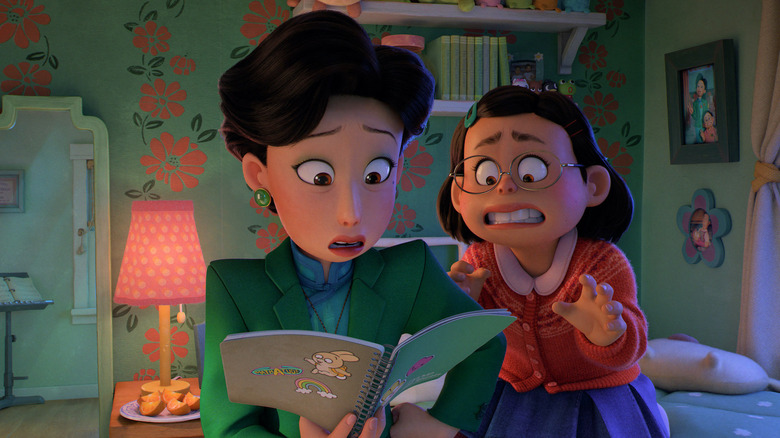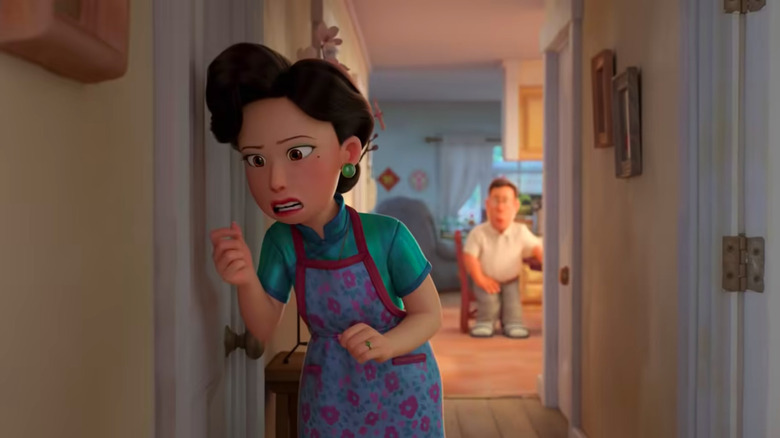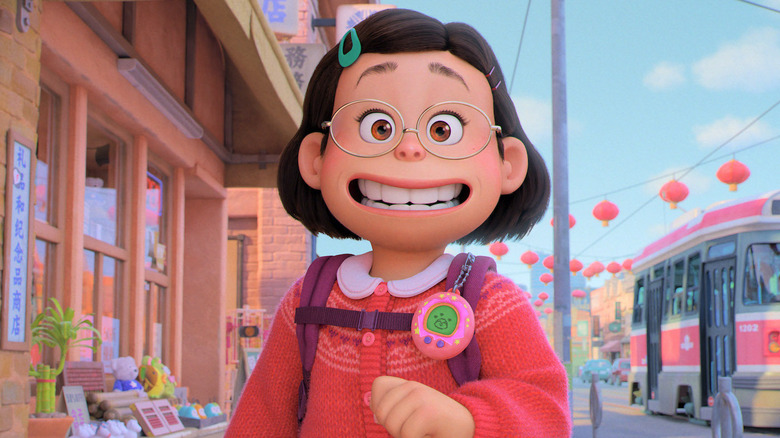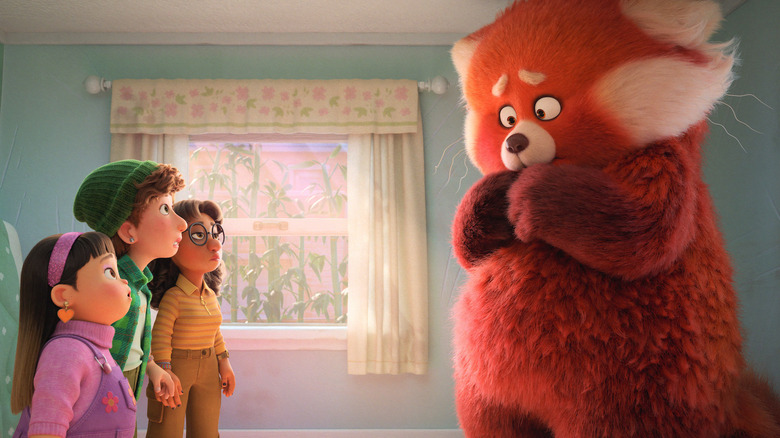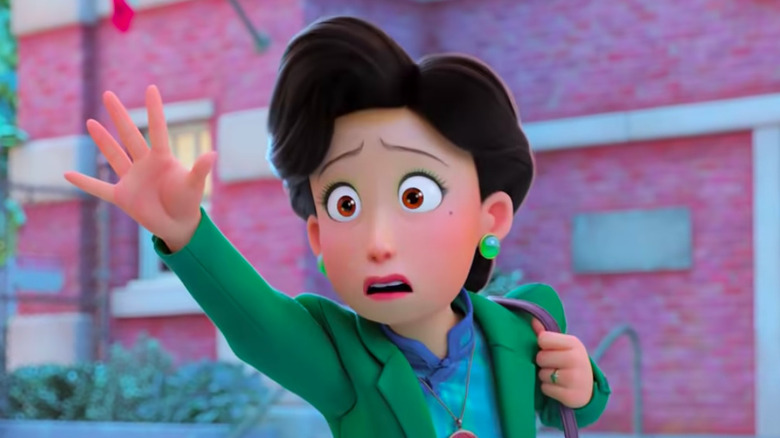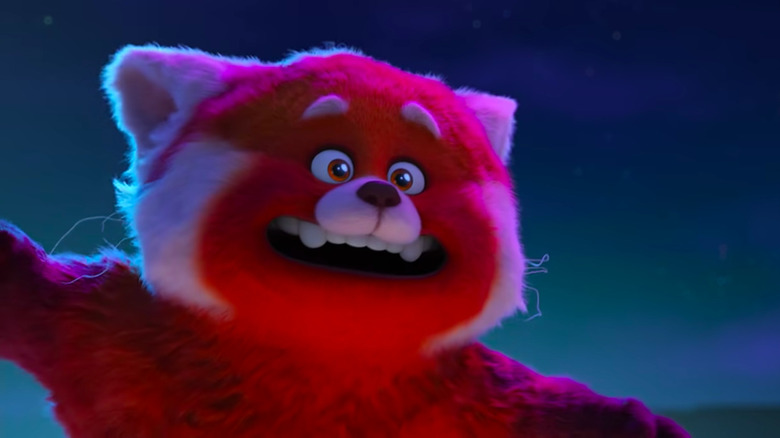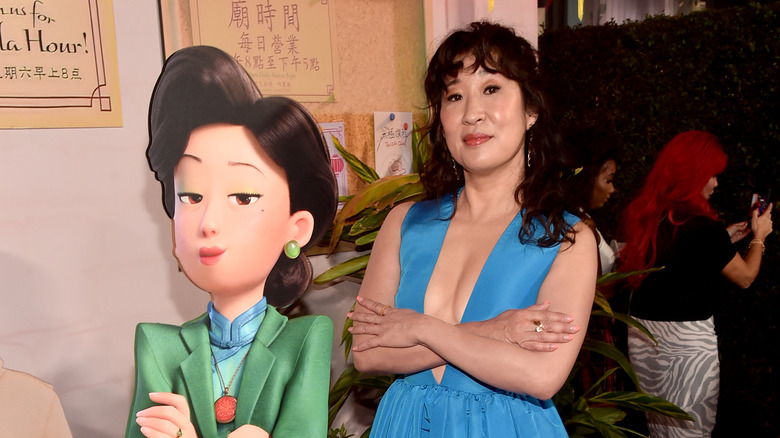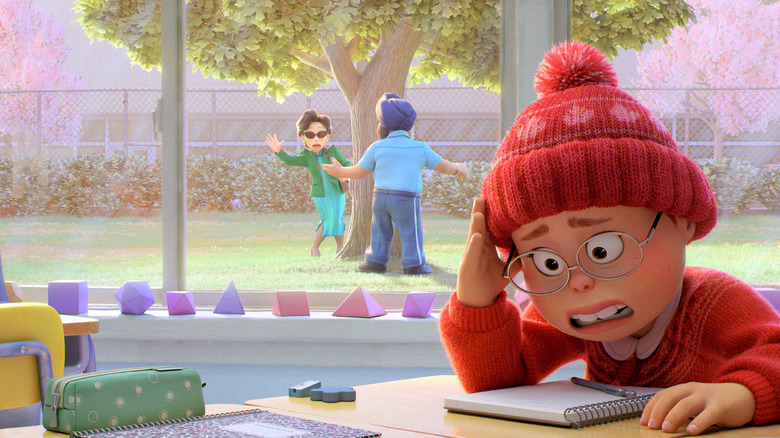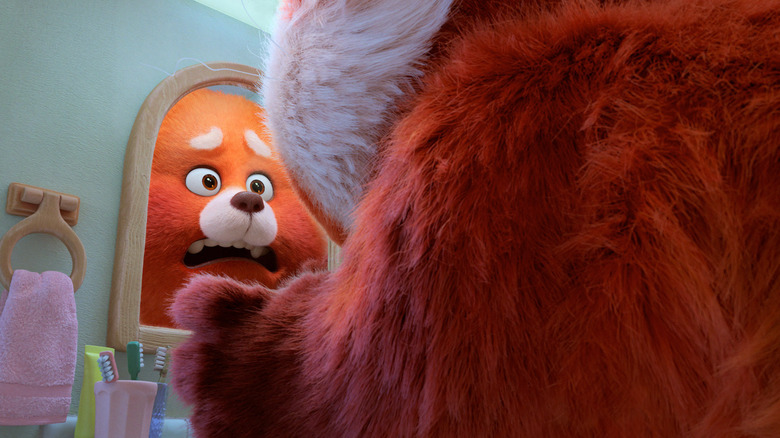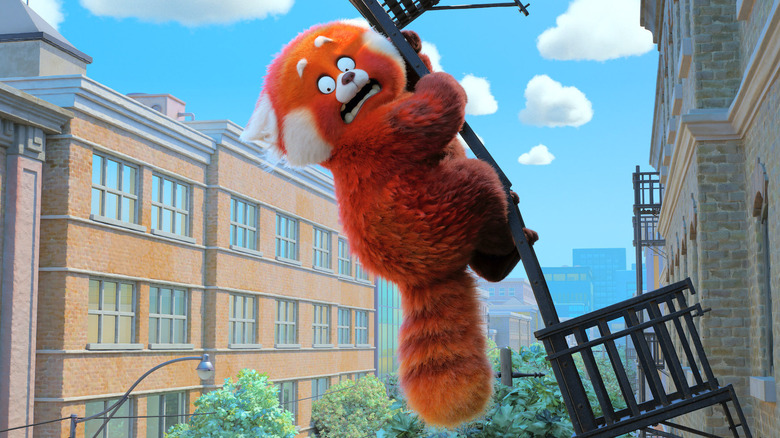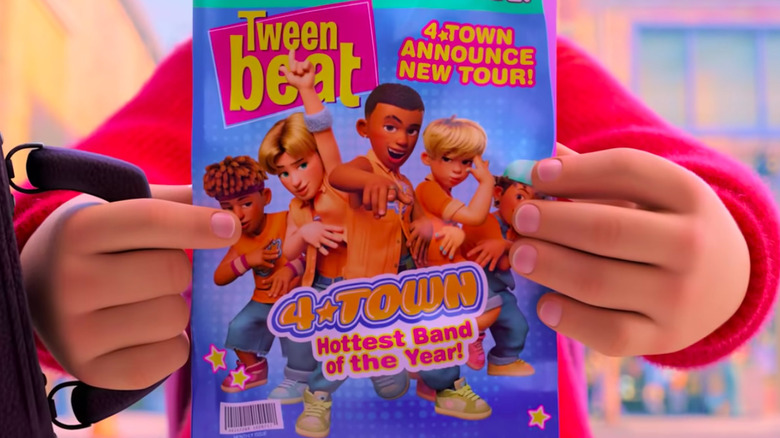Things Only Adults Notice In Turning Red
Pixar is known for making family friendly films that tackle delicate issues in whimsical but relatable ways. And with "Turning Red," the company turns its attention to the challenges of puberty with the tale of Mei (Rosalie Chiang), a girl whose coming-of-age comes with an unexpected surprise: When she gets emotional, she turns into a gigantic, fluffy red panda. While this is definitely cuter than the usual challenges that come with early adolescence, it makes this already confusing period in 13-year-old Mei's life even more mystifying. After all, how does she explain this new side of herself to her friends? And how does she reconcile her desire to be the good daughter her mother Ming (Sandra Oh) relies on with her newfound interest in boys, especially the dreamy boy band 4*Town?
"Turning Red" tackles a time in life that everyone goes through from the perspective of one Chinese-Canadian girl with a very unique dilemma. This makes it highly resonant for those of us who remember early adolescence — and are glad it's over. However, that means in that — in addition to the usual details Pixar includes that are aimed at adults — the movie also features numerous references to puberty that will go over the heads of children who have yet to experience it for themselves. Here are things that only adults are likely to notice in "Turning Red."
But be warned, there are major spoilers for the movie ahead.
The film takes place in the early 2000s
"Turning Red" starts with an extended sequence in which Mei introduces herself by speaking directly to the camera. While breaking the fourth wall isn't unheard of in films, these days we're most familiar with people talking directly to the camera when it's the camera in their smartphones. As a result, it would be understandable if viewers initially think "Turning Red" takes place in the present day. Adults who are old enough to have lived through the late 1990s and early 2000s will soon notice, however, that there are many things about the movie that indicate it actually takes place around 20 years ago.
While none of the kids carry smartphones, there are other details that make the time period even more evident. This includes the fact that the kids are still exchanging CDs to listen to music. In fact, one of the first hints about when the movie takes place happens when Mei's friend Miriam (Ava Morse) gives her a CD of a 1999 concert of their favorite boy band 4*Town. Not only were boy bands like *NSYNC and the Backstreet Boys huge around the turn of the century, CDs were still the preferred method on which to listen to and own music. By the end of the film, the year has specifically been identified as 2002 — but until then, small details offer clues about its time period.
Summing up the trials of early adolescence
While kids learn about puberty in health class, until you go through it, you can't really understand what it's like. As a result, teenagers and adults are likely to relate to the film's depiction of early adolescence and realize just how perfectly the story encapsulates the experience — but young children will probably miss these moments. Adolescence involves physical and emotional changes, and Mei turning into a red panda speaks specifically to the emotional turmoil of this time in life.
Before adolescence, children are perfectly happy spending time with their parents and comfortable letting them dictate how they should be and what they should do. Starting in early adolescence, though, children start becoming more interested in their friends' opinions than their parents'. Plus, they start having all sorts of urges they can't explain, especially sexual urges that never came up before. Mei experiences all of this in dramatic fashion. She wants to remain the perfect daughter in her mother's eyes so she starts to hide things from her, yet at the same time her mother's desire to protect is starting to feel stifling — and Mei wants to rebel. This leads to a whole raft of emotions that are pushing her in several directions at once, nicely summing up the fraught transition from young child to budding adolescent.
Mei's mom's reference to 'the red peony' is about Mei's period
The first time Mei turns into a red panda, it's in response to a nightmare — which means she wakes up in panda form, unaware that her body has undergone a major change during the night. So when she walks into the bathroom and looks at herself in the mirror, she reacts with horror, fear, and tears. Mei's parents can hear her distress from the kitchen where they're eating breakfast, leading Mei's worried mother to venture to the bathroom door to find out what's wrong.
At first, Ming assumes her daughter must be sick, but soon she realizes something more unusual is going on, and she thinks she knows what. Yet, because this is an issue specific to women that's often only talked about in whispers, she uses a carefully considered metaphor to question Mei about it. Through the door she asks, "has the red peony bloomed?" Adults will know Ming is wondering whether Mei has started menstruating. However, children are likely to be just as confused as Mei, whose response to her mother is a less-than-convincing, "No! Maybe ..." — indicating she's not exactly sure what Ming's metaphor means.
Mei carries a popular toy from the late '90s/early 2000s
When Mei introduces herself at the beginning of "Turning Red," she makes a point of showing off a round pink accessory on a key chain attached to the strap of her backpack. While children may not know what it is, adults will recognize it as a Tamagotchi, a toy that was especially popular in the late '90s and early 2000s. Tamagotchi are digital pets that their owners have to take care of by feeding them, training them, and keeping them happy through the toys interface. While the graphics in the models from the early 2000s were rudimentary, kids often got very attached to their Tamagotchi. It seems Mei is one of those individuals, given the way she proudly displays hers on her backpack.
Tamagotchi are still made today, but they're nowhere near as ubiquitous as they once were. Plus, more advanced technology means their graphics are more sophisticated, they can connect to other Tamagotchi, and you can even take pictures with them. Mei's Tamagotchi doesn't have nearly that level of interactivity, but even though the movie doesn't put too fine a point on it, it seems she's done a good job taking care of her digital pet.
Red panda are actually quite small
When Mei turns into a red panda, she grows to be twice her normal height and substantially, er, wider. Yet something adults will pick up on — along with any wildlife-loving children — is that Mei's fantastical size doesn't make sense if she's truly taking on the guise of a red panda. That's because red pandas are fairly small, with adults growing to be only a bit bigger than a pet cat. So although Mei takes on the basic look of a red panda, with her red fur and white accents on her face and ears, if she looked like a real-life red panda, she'd actually get smaller, not larger.
This gets especially ridiculous when Ming lets out her red panda, a Godzilla-sized colossus that stomps through downtown Toronto. Of course, the magic that causes Mei's family to turn into red pandas could be blamed for this, given it seems the size of Mei's and Ming's red pandas is proportional to the big emotions they're feeling. Nonetheless, even though Mei is adorable as a red panda, making her very popular with her classmates, the real-life red panda's diminutive size is one of the things that arguably makes it even more adorable. Large or small, though, red pandas are endangered, so hopefully "Turning Red" will draw more attention to them and maybe even encourage viewers to participate in conservation efforts on their behalf.
The scar on Mei's grandmother's forehead was given to her by Mei's mother
"Turning Red" focuses on the mother-daughter relationship between Mei and Ming, yet there's another mother-daughter relationship that also plays a role in the story: the relationship between Ming and her mother, Mei's grandmother (Wai Ching Ho). When Grandma learns that Mei's red panda has appeared, she travels across the country with Ming's sisters to help with the problem. When she arrives, both children and adults will notice that one of Grandma's most defining features is a prominent red scar across her eyebrow.
No one mentions how she got the scar, but adults will realize a small moment in the film subtly sheds light on what happened. When Mei's grandmother goes to talk to her alone, she mentions that she and Ming used to be close like Ming and Mei are. That is, until Ming's red panda came out and ruined their relationship. As Grandma recounts this, she briefly touches her scar. It's a fleeting moment, but it seems to indicate that when Ming's red panda appeared, her emotions were so out of control that at one point she scratched her mother — leaving her with a permanent reminder of what happened.
Being a red panda becomes like a superpower for Mei
When Mei initially turns into a red panda, it's awkward and scary. She's much bigger, so she can jump farther and climb higher ... but she frequently miscalculates her landings, and falls and stumbles as a result. Later on, she becomes more comfortable with her new form and is able to dance and jump around while switching from panda to human at will. It's a cool party trick, but for the most part nothing more.
Yet, during the climax of the film, when Mei decides she urgently needs to join her friends at the 4*Town concert, her red panda form seems to endow her with superpowers. Mei bounds over rooftops as the panda, periodically switching back to human, only to leap off another building as she switches back again. Then when she reaches the concert venue, she leaps through the open retractable roof, sees her friends in the crowd, and manages to propel herself so she lands right next to them. It's something many of the most seasoned superheroes would have trouble pulling off, and even though both kids and adults will notice Mei's red panda seems to have acquired superpowers, it's likely only adults will be left scratching their heads about how her abilities became so extreme so quickly.
The movie includes some famous voices
The voice cast of "Turning Red" is led by Rosalie Chiang, a newcomer, as Mei. However, there are other names in the cast that are more recognizable, at least to adults. That's especially true of Sandra Oh, who voices Ming. Oh rose to fame playing Dr. Christina Yang on "Grey's Anatomy." More recently she's starred on the assassin drama "Killing Eve" and Netflix's academia-set comedy "The Chair." But even though Oh has been nominated for multiple Emmy Awards, kids aren't likely to know who she is because she's mostly starred in adult-targeted fare
On the other hand, kids may notice that Mr. Gao, the man who performs the ritual to separate Mei from her panda, has a recognizable voice. They may even realize that the actor who voices him is also the voice behind Mr. Ping in "Kung Fu Panda." However, what they may not realize, but many adults will, is that the voice belongs to the actor James Hong, who has had a lengthy career in Hollywood, and has famously played characters like David Lo Pan in "Big Trouble in Little China" and Chew in "Blade Runner."
Many parents end up repeating their parents' mistakes
"Turning Red" makes it clear that Mei is the apple of Ming's eye. She sees Mei as the perfect daughter, and when we meet Mei, she's doing everything in her power to ensure she lives up to her mother's impressions. Yet, Mei is also starting to forge her own identity apart from her mother and her overwhelming expectations. This sometimes leaves Mei screaming into a pillow when Ming gets too overbearing. So when Ming's mother calls and Ming responds with anguish and then cowers as her mother criticizes her over the phone, adults will realize that Ming is heading down a similar path with Mei.
Later in the film, when Ming's mother tells Mei that she and Ming used to be close before Ming's red panda emerged, this perception is reinforced. Just like her mother, Ming wants Mei to stay exactly as she is, but Mei is growing up whether she likes it or not. If Ming remains overprotective as Mei gets older, Mei will soon feel like her mother is suffocating her, just like Ming seemed to with her mother. Although she's unaware of it, Ming's recreating the same kind of relationship with Mei that she has with her mother, the kind where the pair will still love one another but will never be as close again.
The rules around becoming the red panda aren't all that clear
The plot of "Turning Red" hinges on Mei becoming a red panda and the havoc she causes because of it. However, the rules around what triggers her to change forms are never made especially clear. The movie vaguely indicates that any strong emotion will bring out the panda, which means as long as Mei stays calm, she remains human. And while kids are likely to accept this, adults may notice the rules don't always seem consistent.
While initially it appears that only strong negative emotions cause the change, later when Mei starts changing at will, it seems the panda may respond to strong positive emotions as well. Yet, when she discovers that thinking of her friends -– something that fills her with warmth and positivity -– enables Mei to keep her panda in, it seems perhaps this isn't the case.
If that weren't enough, Mei is told that the ritual performed on the night of the red moon is her one chance to get rid of the panda — but when she's in trouble, her mother, grandma, and aunts all smash the trinkets that hold their pandas and once again take on red panda form. Then, when Mei is safe, they once again suppress their red pandas through the ritual, which suggests that, if she wants it, Mei should have a second chance to use the ritual to let go of her panda at a later time as well.
Mei's clothes disappear when she turns into a red panda
Throughout the history of film and television, there have been characters that transform from one form to another, and they've all dealt with the issue of what happens to the character's clothes differently. In most "Dracula" films, for example, the master vampire is unclothed as a bat, but he's fully clothed in evening wear when he turns back into human form. Meanwhile, on the TV show "The Incredible Hulk," David Banner famously loses his shirt when he becomes the Hulk, but somehow his shorts manage to shrink and expand as his form gets bigger and smaller.
Adults who have been sensitized to such details by a lifetime of watching productions like these are more likely than kids to notice that in "Turning Red," Mei stays fully clothed when she's human and has those clothes poof away as soon as her red panda fur comes out. This is understandable given this is a family film, which would make scenes in which Mei finds herself naked or wearing tattered clothes after becoming human again highly problematic. Still it could have been fun to see Mei's red panda form wearing her skirts and sweaters.
The non-threatening marketing of boy bands
The boy band 4*Town is essential to the story of "Turning Red." During the late '90s and early 2000s, tweens and teens went as gaga over The Backstreet Boys and *NSYNC as Mei and her friends do over the boys of 4*Town. The movie perfectly captures how these bands served as a way for early adolescent girls to bond, express themselves, and experience their first crushes in a relatively safe way.
In fact, the film showcases exactly what made these groups so appealing by styling them as nonthreatening pretty boys. They come across as cool and creative, and their songs suggest that if they ever decided to commit to you, they'd love only you, and they'd love you completely. The film even features three original songs written by Billie Eilish and Finneas O'Connell, which mimic the simple but catchy tunes that boy bands are known for and made them popular over the years. Any adult who spent time as a tween swooning over a boy band or dancing with friends to their music will instantly recognize their experience in the depiction of 4*Town.
